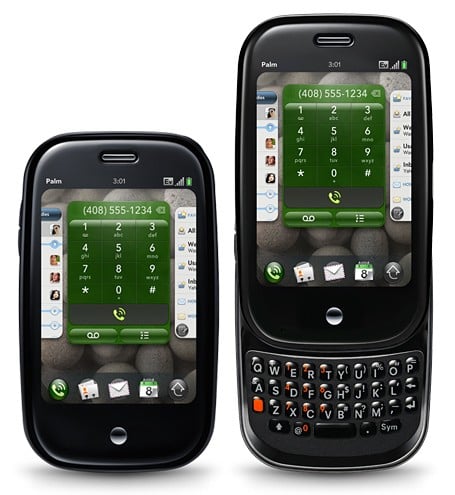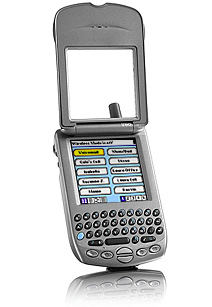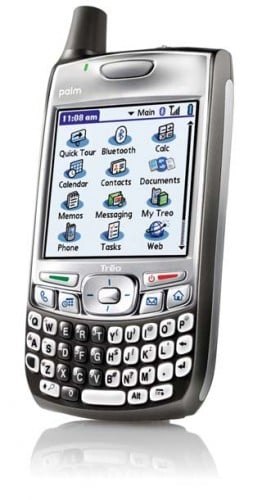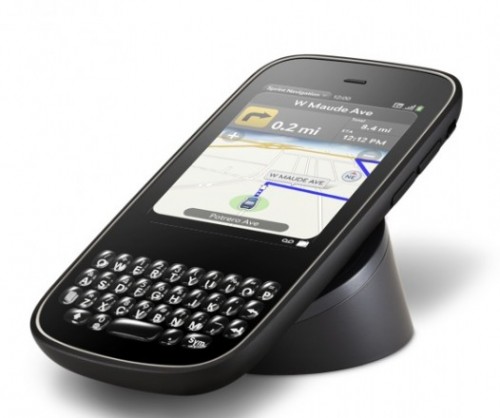
I’ve been a business smartphone user since the category was invented. I started with Palm and have been loyal to them through the years as the market has developed from a niche geek market to the fastest growing segment of mobile communications. Analysts say it will easily overtake conventional cell phones in developed countries very soon.
As a business user, I’ve always assumed the ‘next’ new device would be better than the previous device at getting the job done. That job being primarily communicating with colleagues via voice or text. Originally email was the exclusive text method, but of course today we have SMS, IM, Twitter, Facebook etc.
So why am I upset with what Palm has done in their latest ‘comeback kid’ device, the Palm Pre?
Read on to find out.
I’ve been using Treo’s in my business since they first came on the market from Handspring (before they were acquired by Palm.). My first unit was a Treo 270. This was about 6 years ago.
 The Treo really hit its stride with the Treo 600 (although there were many quality issues with the physical phone) and later was moved into 3g territory with the 700p.
The Treo really hit its stride with the Treo 600 (although there were many quality issues with the physical phone) and later was moved into 3g territory with the 700p.
The name ‘Treo’ got a bit confusing because eventually Palm supported both their own OS and Windows mobile. Many, including myself, would say that the Palm OS was always a better solution in terms of high productivity one handed operation.
However, as time marched on the Palm OS became stale. It was eventually spun into a separate company and later sold to a foreign company. It never even gained mainstream support for technologies such as Wi-Fi. You might think of the Palm OS as similar to Windows 95/98. Yes it was graphical, Yes it was productive and feature rich, but it never had a truly protected memory architecture. They did allow apps to run in the background, but that’s usually what caused slowdowns and crashes – just like (serious) multitasking would often crash windows 95/98.
10 years later even the iPhone can’t really multitask due to the same overall challenges and issues.
What Palm really excelled at was being a great PDA in terms of handling calendars, tasks and notes.
Email came later and was ‘OK’.
Third party email apps such as ChatterEmail really cranked it up a notch and made the Palm Treo a very viable competitor to the Blackberry. Unlike BlackBerry at the time, the Treo would directly connect to most email sources including Exchange without what might be a more expensive extra monthly data fees or middleware servers.
Palm prided themselves on designing the physical phone (they practically invented the ‘candy bar’ form factor) so that you could be productive with one hand. Although the Treo had a stylus, toward the end, it was almost completely unnecessary. Unlike Blackberry of that era, it always had the touchscreen and Palm pretty much invented or at least popularize everyday use of the touchscreen PDA (some would argue that the Apple Newton got there first but it was a commercial flop).
Treo’s use of a ‘5 way’ navigation ring with a button in the middle was much faster than a tiny Blackberry trackball.
 Eventually with the release of the ‘sexy’ iPhone and the ever shrinking physical hardware designs (and pricing) of the Blackberry would force Palm to make a do or die decision to start over.
Eventually with the release of the ‘sexy’ iPhone and the ever shrinking physical hardware designs (and pricing) of the Blackberry would force Palm to make a do or die decision to start over.
After hiring some key original Apple design talent, it was clear Palm was going for sexy hardware and software designs. For me the fear was, and at this point it looks well founded, is Palm sacrificed the productivity and functionality they were known for.
Thus the Palm Pre and WebOS was born and released last June. I bought mine in late August 2009 wanting to give them a chance to get any initial release hardware/software bugs out of it.
On paper the Pre is a great device. It already delivers pretty much everything the iPhone doesn’t and for my use, matches or beats the iPhone on style and visual appeal. The Pre includes arguably the most elegent UI for a true multi-tasking phone. Similar to the differences between Windows 95 and Windows 7 in terms of managing multiple applications.
Palm Pre has delivered a device that is even smaller than the iPhone (but a tad thicker) and it does so with the same screen resolution and, very important to many, a REAL keyboard. GSM and CDMA versions are available and it is available on numerous European carriers and soon US carriers. (Verizon has publicly stated early 2010).
In addition, although they have far fewer apps ( one fart application instead of 20 like the iPhone) most of the important ones are there. In addition, Palm and Sprint have stated their intent to be MUCH looser on what they will allow in the App Store and what they won’t. Because the Palm Pre multitasks, many of these apps are much more productive. For example you can listen to Pandora while doing something else. You can use the excellent FREE Sprint Navigation and listen to Pandora (which will mute while a turn is being spoken) and surf the web all at the same time. (Of course that web surfer better be the passenger 🙂 ) Oh, and then Trapster can notify you when you are approaching a police radar trap. Although the iphone has a Trapster app, it can’t notify you of upcoming traps while you drive unless that is all your phone is exclusively doing. It’s the multitasking that is probably the biggest differentiator between the Pre and the iPhone.
The Problem The Pre Must Overcome
The phone has been fairly successful considering its only on one US carrier who is not the market leader (Sprint). However, less than 1 million units total have been sold while the iPhone has sold something like 24 million.
The real problem I’ve had with the Palm Pre goes back to my argument with friends about Web based apps versus native applications on a PC. In almost every case a native application runs faster and more productively than HTML based applications.
Virtually everything that runs on the Pre is written the same way you would write a web application (hence the name WebOS). This means millions of developers should be able to come up to speed quickly and that code written for the Pre can be easily ported to the web and vice versa.
The reality is this adds many layers of overhead to the device. In my daily usage many applications run substantially slower on the Pre than their counterparts did on the Treo, even though the Pre’s hardware and processor can run rings around the Treo’s.
Simply put, the Pre has one of the faster mobile CPU’s on the market today, and yet the device runs, in many cases, as the slowest mobile device on the market. It’s processor is a TI OMAP and runs at 600mhz, the same speed as the iPhone 3gs processor and the same processor as the upcoming Droid. Yet this simple test points out what we’ve known for years, hardware alone does not determine end user experience.
Not only that, but in the rush to get the product out to market, Palm seems like they cut alot of corners in functionality and application design. Case in point, it takes me almost 20 seconds to enter an appointment on the Pre Calendar between gestures, navigating and waiting. It took about 1/3 that time with a Treo. It’s faster to write down an appointment and enter it later than be embarrassed in front of the Dentist trying to put your next appointment in your Pre.
The email app (IMHO the most important non-voice app on a mobile device) has almost no previewing of emails when looking at your inbox. So it takes 3 to 5 seconds every time you tap and email header until the time you are seeing the contents. Doing this with scores of emails daily makes it very slow. Much slower compared to the Treo. They don’t even have a mechanism to mass delete emails. you have to swipe delete one at a time and it often is unresponsive to your gestures due to the problems mentioned above.
When you watch their ads, pay very close attention to those fine print notices that the screens have been sped up for presentation purposes.
I could go on but simply put, Palm needs to either optimize the OS and key applications soon, or come out with a new hardware unit with a processor that is 2x faster. Instead, the Pixie is coming out soon and has an even slower processor than the Pre.

Palm Pixie
To me Palm looked like they were on the verge of a huge comeback, but now they seem to be running out of steam.
This couldn’t come at a worse time. After spending well over a year wallowing, it seems that a wave of new Google Android devices on so many different carriers has the potential to smother the Pre. Even Sprint, the flagship launch carrier of all past Palm devices is carrying Android devices including the HTC Hero.( HTC used to contract manufacture Treo’s for Palm).
There are more and more apps that seem to be going Android but not Pre. Most of the ‘cloud’ services for example. I love SugarSync, and of course they have an iphone app, a new Android app, but no mention of Pre.
Palm has got to pull out all stops now or this rocket may run out of fuel before reaching escape velocity.
My opinion:
Have to get on Verizon (AT&T additionally would be a plus) and not just appear, but have major POP exposure. Otherwise ‘Droid’ is going to bury them into insignificance.
They have to figure out what makes this OS so sluggish at times need to speed up the Pre. With that, they have to rewrite the killer apps – mainly email and calendar. Entering data into each of the core applications is too slow and cumbersome.
They have to continue to aggressively pursue developers and open up the device to lower level apps. Even if it risks a few going haywire as these apps just don’t compare to the iPhone’s unless they are pure web type apps. The Pre has a high performance dedicated Graphics Process Units (GPU) and yet it sits their idle because WebOS doesn’t appear to make use of it. That’s partly why transitions are choppy and sluggish as it’s all juggled by the CPU.
In addition, I feel they need to release some new form factors fast. Perhaps a Pixie Sr. that is bigger and more inline with like a Treo 700 (but much slicker and thinner). We all would love essentially a Pixie with a bigger screen and keyboard. The Pre’s slider make the phone look cool but detracts from one handed operation and appears its going to be the physical fault point of the majority of these phones.
In my opinion if they can’t accomplish all of the above in six to twelve months it’s acquisition time or game over for Palm.